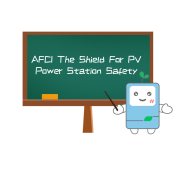AFCI: The Shield For PV Power Station Safety
As PV and energy storage systems are increasingly deployed in commercial and industrial sectors, as well as in homes and farms, they become more intertwined with daily life and production activities. While providing us with clean and convenient energy, it is crucial to ensure the safety of people and property, and to promote the healthy and sustainable development of the industry.
- Risks Associated with DC Arc-Fault
In PV systems, the DC component circuits often operate at high voltages, typically about 600-1000V. Various issues in the DC circuit, such as aging and corrosion of cable connections, connector failures, model mismatches, loose connections, and damaged insulation materials, can all lead to the generation of a DC arc fault.
A DC arc fault occurs at a cabling joint where there is a breakdown, causing the flow of electrical energy to break through the air and resulting in continuous sparks. Unlike an AC arc, which has zero-crossing point, a DC arc is much more hazardous. Once it occurs, it can cause a sharp rise in the temperature of the conductor joint, generating extremely high temperatures of 3000-7000℃. This can result in blown fuses and melted cables in mild cases, or, in severe cases, it can destroy components and equipment, potentially causing fires. Statistics show that over 80% of fire incidents in PV power stations are caused by faults on the DC side.
Therefore, it is crucial to address DC arc fault to ensure the safe operation of PV systems.
- AFCI Technology: The Safety Shield
DC arc faults are challenging to detect, making it essential to avoid false alarms and missed detections. This is why AFCI (Arc Fault Circuit Interrupter) technology has been introduced, as it addresses both arc detection and interruption.
The implementation of AFCI technology effectively enhances the safety performance of PV inverters. Utilizing optimized algorithms, it enables rapid detection and immediate interruption of arc faults, offering better noise resistance and adaptability to various scenarios compared to traditional solutions.
Noise Adaptability: The operating environment for distributed PV equipment is varied and complex. Traditional arc fault detection algorithms and thresholds, which are mainly based on human experience, may struggle to effectively distinguish environmental noise and arc spectrum characteristics. Additionally, in parallel and ground arc fault detection, baseline noise can vary across different environments, making precise identification challenging with conventional technology.
Scenario Adaptability: As PV module currents and the power output of individual inverters continue to rise, the cable lengths on the DC input side and the maximum arc current in real-world scenarios may exceed those of standard test conditions. The arc signal diminishes with higher currents and longer cable lengths, necessitating greater precision from detection instruments and algorithms.
In regions such as North America, Europe, Australia, and Brazil, the detection of DC arc faults and the rapid shutdown (RSD) function are becoming standard requirements. Rooftop PV systems must be equipped with AFCI capabilities, adhering to detailed specifications regarding arc current levels, gaps, detection times and wiring methods for arc testing.
Senergy SE series inverters can be equipped with AFCI functionality based on customer requirements and are compliant with North American UL1699B-2018 and European IEC63027 standards. Senergy inverters meet industry standards for detection range, detection accuracy, and shutdown response time.




